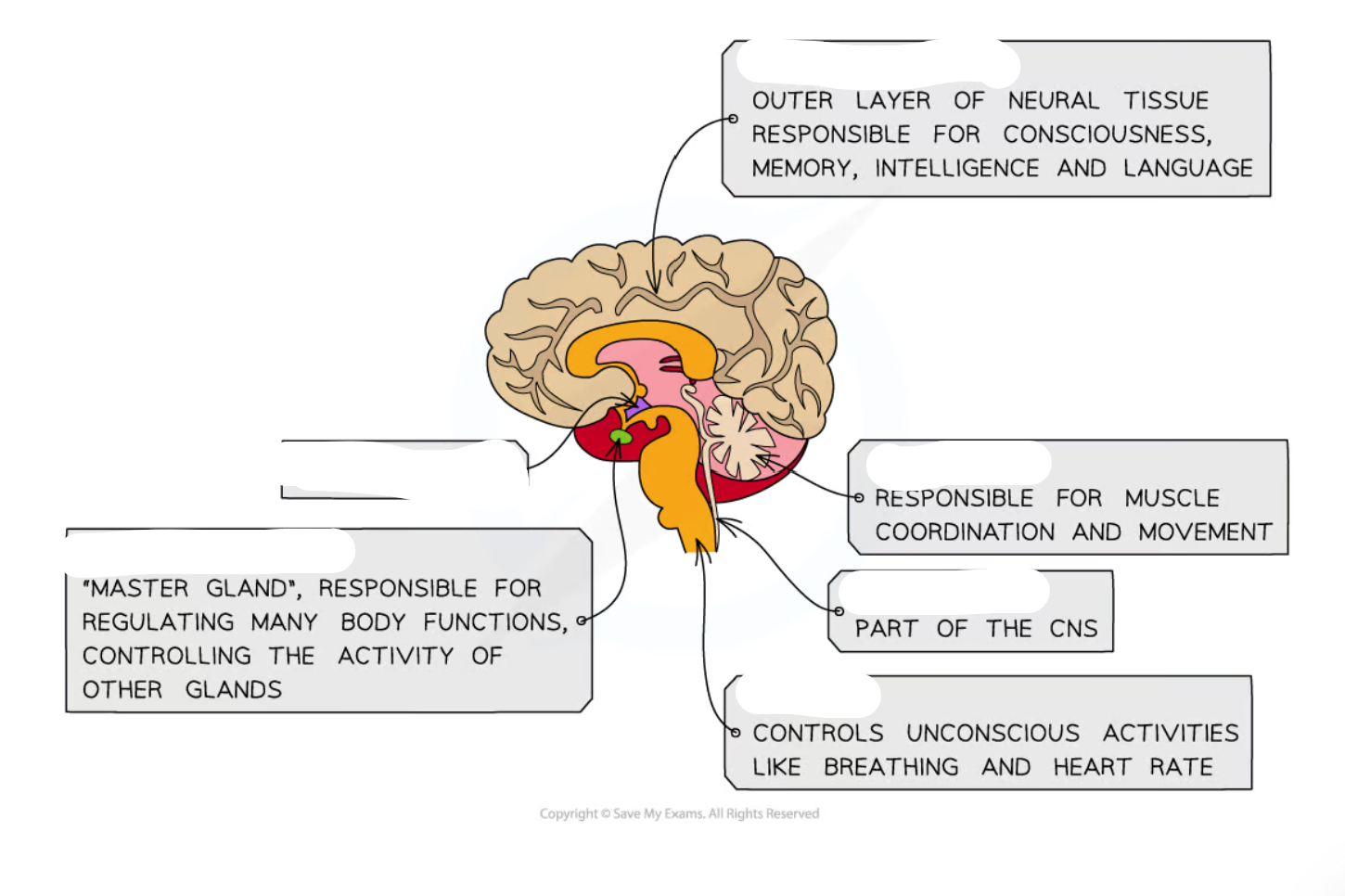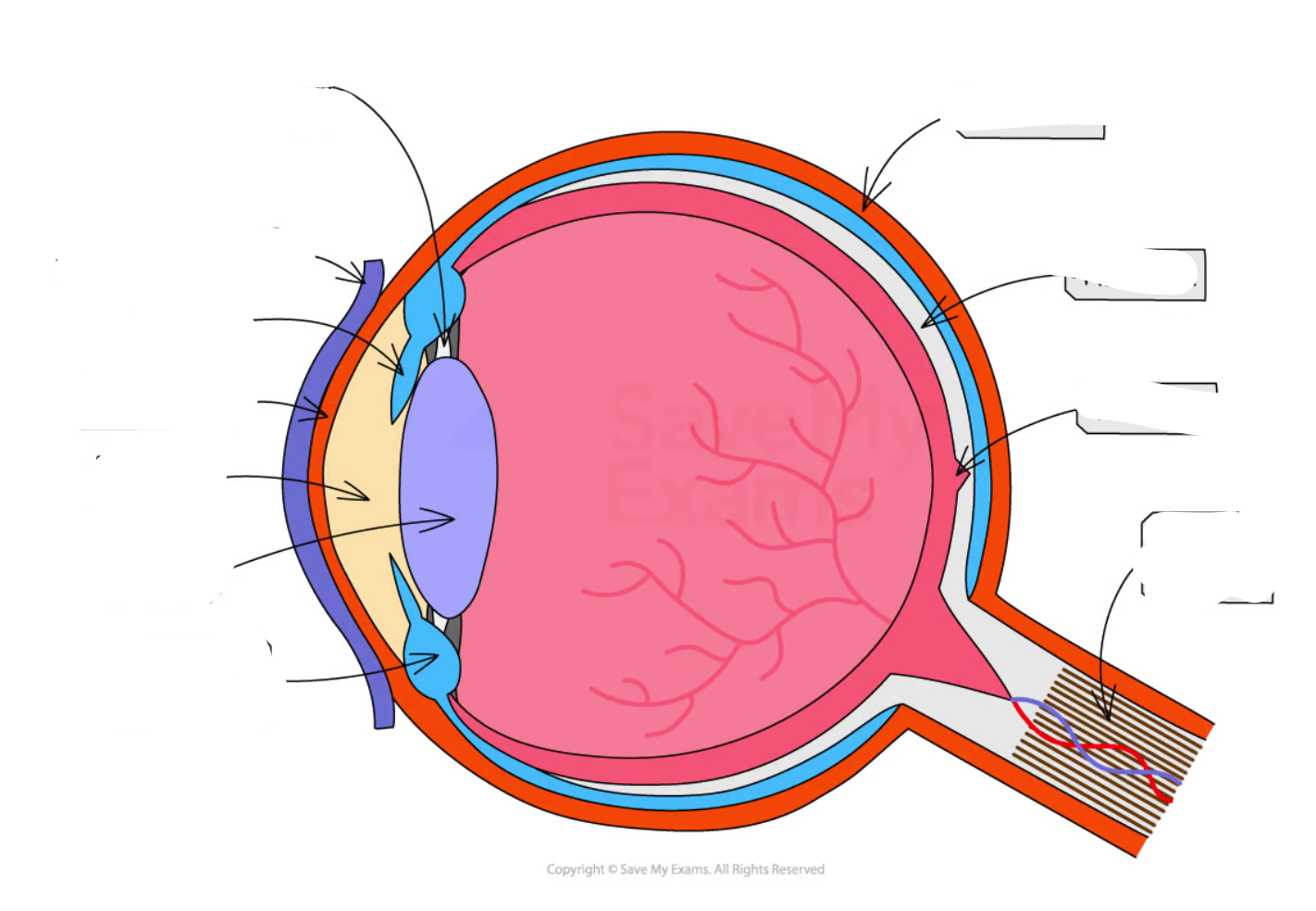Biology Homeostasis - The human nervous system
1/18
There's no tags or description
Looks like no tags are added yet.
Name | Mastery | Learn | Test | Matching | Spaced |
|---|
No study sessions yet.
19 Terms
Pathway of nervous system
Stimuli → Receptor → Sensory neurone → Coordinator (CNS) → Motor neurone → Effector (glands and muscles) → Response
Reflex arc
Stimulus detected by receptor in skin.
Sensory neurone sends electrical impulses to the spinal cord.
The electrical impulses are passed to a relay neurone in the spinal cord.
The relay neurone synapses with a motor neurone.
The motor neurone carries an impulse to a muscle or gland.
The muscle will contract or the gland will secrete.
Synapses (only in reflex arc)
Electrical impulse reaches end of neurone.
Chemical (neurotransmitters) diffuses across synapse.
Chemical stimulates impulses in neurone B.
Cerebral Cortex
Responsible for higher order processes such as intelligence, consciousness, memory and personality.
The Cerebellum
Responsible for balance, muscle coordination, and movement.
Medulla
Controls unconscious activities such as heart rate and breathing.
Pituitary gland
Master gland - controls other glands bringing about hormonal response.

Cerebral cortex, cerebellum, spinal cord, medulla, pituitary gland, hypothalamus.
3 ways we can study/investigate the brain
Studying people with brain damage.
Electrically stimulating different parts of the brain.
MRI scans.
How can a fMRI scanner help to find out more about a person’s brain damage.
Can ask people to do different tasks whilst taking scan.
To see which part of brain is active/inactive.
Compare with a person without brain damage.
To see exactly where the damage is.

Suspensory ligament
Conjunctiva
Iris
Cornea
Pupil
Lens
Ciliary muscle
Sclera
Retina
Fovea
Optic nerve
What does the eye do in dim light? (adaptation)
The pupil dilates to allow more light into the eye. This is controlled by the iris. Radial muscles contract.
What does the eye do in bright light? (adaptation)
The pupil contracts to allow less light into the eye. This is controlled by the iris. Circular muscles contract.
Accommodation to focus on a near object.
Ciliary muscles contract.
Suspensory ligaments loosen.
Lens becomes thicker and refracts light more strongly.
Light is focused correctly on the retina.
Accommodation to focus on a far object.
Ciliary muscles relax.
Suspensory ligaments tighten.
Lens becomes flatter and refracts light less.
Light is focused correctly on the retina.
Myopia (short-sightedness) (can see close object clearly)
Lens is too thick so light rays are focused in front of retina.
Concave lens is used to refract light rays outwards so that they focus on the retina.
Hyperopia (longsightedness) (can see far objects clearly)
Lens is too thin and light rays are focused behind retina.
Convex lens refracts light more so that it focuses on the retina.
What does the body do if temperature is too high?
Thermoreceptors in the hypothalamus and skin detect the change.
Blood vessels vasodilate which increases blood flow to the skin, this allows more heat in the blood to be lost to the surroundings.
Sweat is produced from sweat glands which cools the skin as it evaporates.
Hairs lie flat.
What does the body do if temperature is too low?
Thermoreceptors in the hypothalamus and skin detect the change.
Blood vessels vasoconstrict reducing blood flow to the skin.
Sweating stops.
Skeletal muscles contract creating shivering which increases heat released in the body.
Hairs stand up trapping air around the skin acting as an insulator.